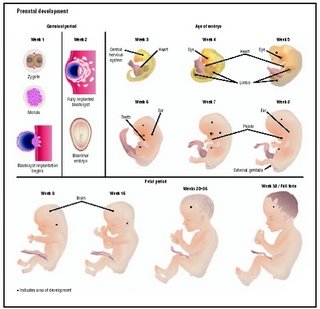Prenatal Development

Imagine how you came to be. Out of thousands of eggs and millions of sperm, one egg and one sperm united to produce you :) Coming to the prenatal Development, the whole process takes place by three periods. The Germinal period, Embryonic period and Fetal period. I didn’t want to bore you guys by explaining the first two periods; you might realize I am talking science! I liked the fetal period which is all about your three trimesters. Don’t you think that is something interesting we would all like to know?
Fetal period is the prenatal period of development that begins two months after conception and lasts for seven months, on the average. Growth and development continue their dramatic course during this time.
Conception to 1 month (4 weeks)
- Is less than 1/10inch long
- Beginning development of spinal cord, nervous system, gastro-intestinal system, heart and lungs.
Two months ( 8 weeks)
- Is just over 1 inch
- Face is forming with rudimentary eyes, ears, mouth and tooth buds.
- Arms and legs are moving.
- Brain is forming
- Fetal heartbeat is detectable with ultrasound.
Three months (12 weeks)
- The fetus is about 3 inches long and weighs about 1 ounce.
- It has become active, moving its arms and legs, opening and closing its mouth, and moving its head.
- It can swallow and the kicking startsJ
- The face, forehead, eyelids, nose, and chin are distinguishable, as are the upper arms, lowers arms, hands, and lower limbs.
- The genitals can be identified as male or female.
Four months (16 weeks)
- The fetus has grown to 6 inches in length and weights 4 to 7 ounces.
- Fingernails and toenails are forming
- Heart beat is strong
- Skin is thin , transparent
- Downy hair(lanugo) covers the body
- Prenatal reflexes are stronger; arm and leg movements can be felt for the first time by the mother
Five months (20 weeks)
- The fetus is about 12 inches long and weights close to a pound.
- Heartbeat is audible by stethoscope
- Sucks thumb
- Hiccups
- Structures of the skin formed- toenails and fingernails, for example.
- The fetus is more active, showing a preference for a particular position in the womb.
- Stimulated or irritated by sounds and lights :)
- The fetus is about 14 inches long and already has gained another half pound to a pound.
- The eyes are eyelids are completely formed and a fine layer of hair covers the head.
- Skin is wrinkled and covered with a protective coating (vernix caseosa)
- They can open the eyes but the vision is unclear.
- The fetus is about 16 inches long and has gained another pound, now weighing about 2-3 pounds.
- Increase body fat and adjust to the temperature
- A grasping reflex is present and irregular breathing movements occur.
- Very active
An important point that needs to be made is that the first time a fetus has a chance of surviving outside of the womb is the beginning of the third trimester (at about seven months). An infant born in the seventh month usually needs assistance in breathing.
Eight months (32 weeks)
- Is 16 ½ to 18 inches long and weighs 4-5 pounds
- Has periods of sleep and wakefulness
- Responds to sounds
- May assume the birth position
- Bones of head are soft and flexible
- Less active since it is cramped- no space
Nine months ( 36- 38 weeks )
- Is 19 inches long and weighs 6 pounds
- Skin is less wrinkled
- Vernix – a cheesy smoothie kind of stuff which is covered the fetal body gets thick to help the baby to come out smoothly:)
- Lanugo ( hairy part) is almost gone
- Is gaining immunities from mother
- Rotate into an upside down position
- Getting ready for the birth:)




